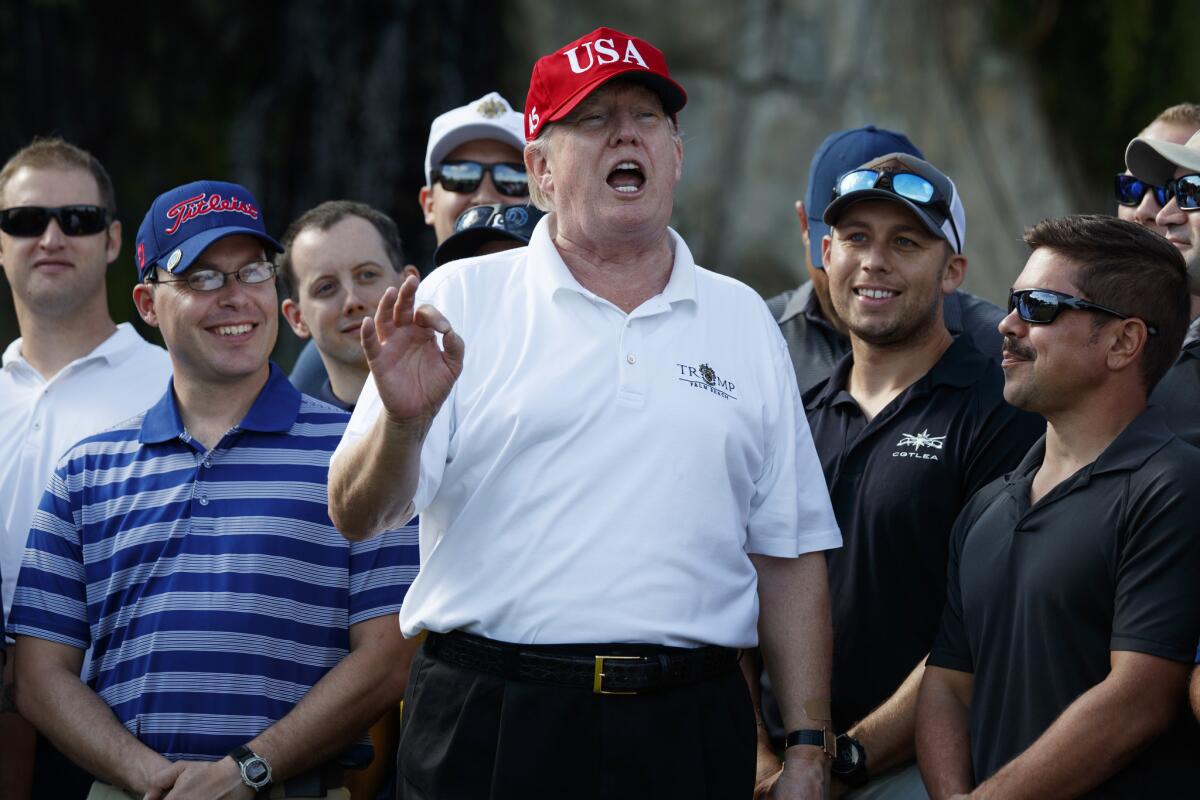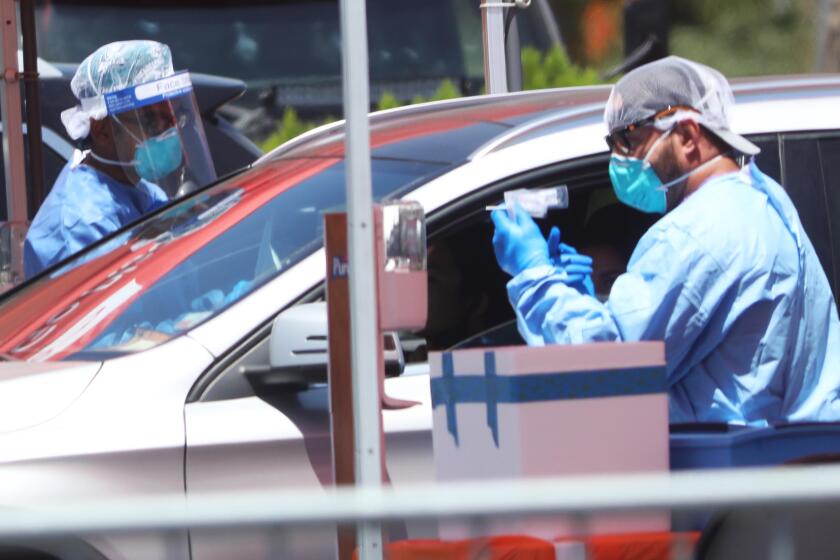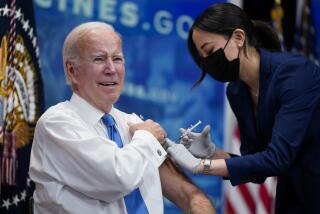Column: Unsurprisingly, Trump’s rollout of the COVID vaccine is an utter fiasco

For some mysterious reason, people are shocked — shocked! — that distribution of COVID-19 vaccines in the U.S. has been screwed up.
And screwed up it is. As of Monday, about 11.4 million doses of the Pfizer and Moderna vaccines have been distributed, according to the Centers for Disease Control and Prevention. But only 2.1 million people have been vaccinated.
By the administration’s own standards, this is a massive failure. On Dec. 10, Health and Human Services Secretary Alex Azar promised that 20 million Americans would be vaccinated in “the next several weeks.”
It is up to the States to distribute the vaccines once brought to the designated areas by the Federal Government.
— President Trump
Considering that it will be three weeks since then this weekend, that’s obviously not going to happen. So the White House moved the goalposts, promising that 20 million doses would be distributed by the end of the year. Then it revised its pledge to 20 million doses by the first week of January. Either way, the prospect of meeting that self-imposed mark is dim.
Projecting the pace of actual vaccinations into the future yields a grim conclusion.
Based on the judgment that 80% of Americans, or 264 million people, would need to be inoculated for the nation to reach herd immunity — that is, enough immunity that the virus can’t spread significantly even among the unvaccinated — public health expert Leana Wen of George Washington University estimated that “at the current rate, it would take the United States approximately 10 years to reach that level of inoculation.”
President-elect Joe Biden spoke out about the lagging effort. In a statement Tuesday, he said the country would have to step up its vaccination rate five- or six-fold to meet his own goal of fully vaccinating 50 million Americans (that is, with both doses of the two-shot Pfizer and Moderna vaccines) in his first 100 days in office.
At the current rate, he said, “It’s going to take years, not months, to vaccinate the American people.”
The federal government has poured billions into COVID-19 vaccine research, but will Americans reap the profits?
It’s proper to acknowledge that major public health projects such as mass vaccinations are difficult and prone to missteps and disappointment in their early stages.
The launch, for instance, of the government website for Affordable Care Act health plan signups starting Oct. 1, 2013, was a landmark in botched technology. But the Obama administration took matters in hand, and within weeks the site was up and fully functioning.
The Trump administration had seven years to absorb lessons from the Obamacare debacle but doesn’t seem to have done so. It blindsided several states in mid-December by informing them that their allocations of the Pfizer vaccine, the first to be approved for widespread use, would be as much as 40% below initial expectations.
Government officials attributed the confusion to misunderstandings of the original promises, but for many governors that explanation didn’t hold water.
Gen. Gustave Perna, the chief operating officer of the government’s Operation Warp Speed funding program for the vaccines and other anti-pandemic products, later acknowledged that the confusion resulted from “a planning error, and I am responsible.”
At a press briefing Wednesday, Moncef Slaoui, the chief scientific adviser to Operation Warp Speed, acknowledged that the vaccinate rate as a proportion of available doses is “lower than what we hoped for.”
But Perna, at the same briefing, tried to put a happy gloss on the record. “Everybody collectively should be very proud,” he said. “It has been a whole of America approach.”
Yet many of the factors slowing the pace of vaccinations are obvious. They include inadequate planning and the administration’s refusal to take more of the task in hand. The latter reflects Trump’s approach to the pandemic from the start. Boiled down to its essence, that approach has been: “It’s not our problem.”
As recently as Tuesday, Trump was blaming any problems on state governments. “It is up to the States to distribute the vaccines once brought to the designated areas by the Federal Government,” he tweeted. “We have not only developed the vaccines, including putting up money to move the process along quickly, but gotten them to the states. Biden failed with Swine Flu!”
But experts say that leaving vaccine administration solely to the states is no answer at all. What was needed—and isn’t coming—is federal coordination.
There has been “no real planning on what happens when vaccines arrive in state,” Ashish Jha, dean of the Brown University School of Public Health, tweeted this week. “No plan, no money, just hope that states will figure this out.”
The state health departments likely to inherit the task of vaccine management are already hopelessly overstretched, Jha observed. All year long they’ve been grappling with the need to “manage all the testing, data analysis & reporting, providing advice to businesses, schools, doing public campaigns, etc. Non-stop.” Now they’ll have vaccination loaded on their plates.
Mass vaccination programs like that needed for COVID-19 aren’t unprecedented. The oft-cited model is a smallpox vaccination campaign conducted in New York City after an outbreak was detected in 1947.
The city set up vaccination stations in police precincts, municipal buildings, community centers and “practically every hospital in the city,” Israel Weinstein, the city health commissioner, reported a few months later. Shots were given free of charge.
Mayor William O’Dwyer called for universal vaccination and received one himself, as did President Harry Truman, who traveled to the city for the purpose. The program enjoyed a level of cooperation between officials and the public, government support and popular faith in science that have all been undermined today.
“In a period of less than a month, more than 6,350,000 people were vaccinated,” Weinstein wrote, “over 5,000,000 of them within the two week period following the appeal for universal vaccination made by the Mayor.”
By contrast, the vaccine rollout is being ceded to pharmacies, whether local or parts of big chains such as Walgreens and CVS. But those retailers don’t have the ability to coordinate local or regional vaccination programs, which involve ensuring that everyone in a vaccination group, whether designated by age, health condition or job description, can be found and prompted to report for vaccination when it’s his or her turn.
Furthermore, the Trump White House hasn’t exploited all the capabilities it has available for manufacturing and distributing the COVID-19 vaccines.
Trump’s record of cozying up to anti-vaccine advocates dates back more than a decade.
For example, despite the constraints on vaccine supply caused by limited manufacturing capacity, the government has left to Moderna and Pfizer the sole right to contract with manufacturers — even though federal law gives the government the right to “march in” and make its own manufacturing deals in exactly this situation.
Murky advice from the CDC about which cohorts should receive priority for vaccination during a period of straitened supply has left states to craft their policies on their own. Even in ideal circumstances, not every state might adhere to CDC recommendations, but the situation isn’t helped by the Trump administration’s systematic destruction of the reputation of the CDC, once the gold standard for public health agencies.
Florida and Texas, for example, have started giving shots to residents over 65, moving “essential” workers — those who need to come into frequent contact with the public to do their jobs — further back in line.
“The problem is people that are 73, 74 would be in the back of the line for a young 21-year-old worker who’s considered ‘essential,’” Florida Gov. Ron DeSantis said. “That doesn’t, I think, make sense.”
According to one account, elderly residents in southwest Florida were prompted to report personally to vaccine centers, where they waited in maskless crowds for hours.
No system for enforcing priority rules for vaccines appears to exist, leading to the likelihood of line-jumping by people with low priority but a surfeit of pull. Moderna announced Tuesday that it would make its vaccine available to its “workers, contractors and board members” and adult members of their households “to reduce the risk of absenteeism and disruption due to a COVID-19 infection.”
That’s a good case to be made for workers. As for board members, this privileged group of nine includes, in addition to Moderna CEO Stephane Bancel, three business executives (two retired), an MIT professor and four venture investors.
Among all the loathsome recipients of Trump pardons or commutations, healthcare fraudster Philip Esformes stands out.
Among other early recipients are White House staffers, Vice President Mike Pence and members of Congress and designated staff members. Under normal circumstances, this would make sense in the interest of the continuation of government in a crisis.
But it’s a hard pill to swallow, so to speak, when so many of the newly inoculated will be legislators and other political leaders who have spent much of the last year dismissing the seriousness of the pandemic, refusing to set an example of responsible mask-wearing and social distancing, and voting against assistance for ordinary Americans facing death, illness and economic hardship.
Pence, for instance, was blaming “the media” back in June for promoting alarm about a second wave of COVID-19 infections, since daily average new cases had fallen to 20,000 from 30,000 in April and 25,000 in May. Average new case rates currently stand at 194,500 per day. This happened on his watch as head of the White House coronavirus task force, a job at which he has been majestically ill-prepared.
President-elect Biden and Vice President-elect Kamala Harris also received shots, in public, but that’s consistent with their approach to the pandemic and their support for public health initiatives in the crisis.
It’s possible, even likely, that the vaccine program is just experiencing birth pains. That’s the view of Kevin Drum of Mother Jones, who writes that “this problem will probably get sorted out in the next few weeks and people will soon forget that it ever happened.”
He may be right. But if so, that will likely be because the program will be taken over by a new administration starting on Jan. 20, one that has already started assembling a pandemic task force of experienced experts in epidemiology and public health, devoid of the sycophants and incompetents who have predominated in the Trump administration.
Biden at least knows he’s facing an elemental challenge, and he hasn’t shown any inclination thus far to shun responsibility for meeting it.









